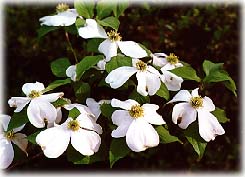Cornus alba ( White Flowering Dogwood )
Find your zone using Garden Web's Zone Finder

Culture: Light: Partial or broken shade is best, but flowering dogwood can tolerate full sun, too. It does best with some shade in the south and full sun in the north. Moisture: Established specimens are tolerant of normal dry periods, but will need supplemental watering during extreme droughts. Stress of any kind makes dogwoods susceptible to diseases.
Hardiness: USDA Zones 5-9.
Usage: Flowering dogwood is one of the most popular
ornamental specimen trees in eastern North America. Use dogwood
as a framing tree or as a background tree. They are excellent
beneath large oaks or pines. Dogwoods are among the earliest
springtime bloomers, brightening the landscape along with
azaleas, spireas, forsythias and redbuds. With its dense crown,
flowering dogwood provides good shade, and due to its small
stature, it is useful in the smallest yards.
The wood of dogwood is very hard and has some value in the
forest products trade for such things as commercial loom
shuttles and spindles. In colonial (U.S.A.) times, a tea brewed
from the bark was said to reduce fevers. Squirrels and birds
devour the pretty red fruits.
Features: The graceful yet compact shape and brilliant
springtime blooms make this a favorite landscape tree
throughout its range. The flowering dogwood is just about the
finest flowering tree you can find. It is beautiful in all
seasons and even though it is nearly ubiquitous in home
landscapes, it never seems to be overplanted.

